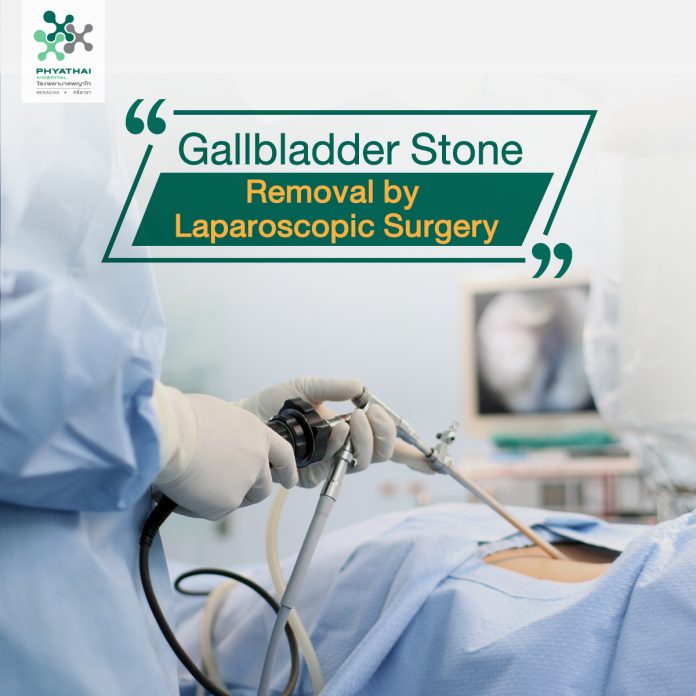What is the gallbladder?
Your gallbladder is a small organ in your upper abdomen. The abdomen is the area in the middle of your body that holds many organs, including the stomach and gallbladder.
What does the gallbladder do?
The gallbladder collects and stores a liquid called bile that helps your body break down food. Small, hard deposits called gallstones can form in the gallbladder. This is a common condition. If your gallstones cause health problems, doctors might do surgery to remove it. For example, you might need surgery if your gallbladder is no longer working correctly and you have pain. Your doctor will talk with you about this.
In the past, doctors made a large cut (incision) in the belly to remove the gallbladder. This is called open surgery. Today, doctors can do this surgery with tiny instruments and just a few small cuts. This is called laparoscopic surgery, because the main instrument is called a laparoscope. Minimally invasive surgery is a general term for surgery with these small instruments.
What Causes Gallbladder Problems?
Gallstones are often the cause. These small, hard deposits form in the gallbladder. They can also get into the bile duct, which connects the gallbladder with your intestines.
You are more likely to get gallstones if you:
- Are a woman,
- Have had children,
- Are overweight, or
- Are over 40.
You might also get gallstones if other people in your family had them. Doctors do not have a consistent way of preventing gallstones.
What are the symptoms of gallbladder problems?
Symptoms can include:
- Sharp pain in your abdomen,
- Nausea and vomiting,
- Indigestion,
- Fever, and
- Yellow skin – Jaundice is the medical term for skin and eyes that look yellow. You might get jaundice if gallstones block your bile duct.
How do doctors find gallbladder problems?
Your doctor will probably order a test called an ultrasound. It shows the inside of the body using sound waves. You are awake during the test, and it does not hurt.
If you need more tests, you might have a CT scan or a test called a HIDA scan. The HIDA scan uses an injection of dye to show how well your gallbladder and bile duct are working.
How do doctors treat gallbladder problems?
Taking the gallbladder out is usually the best way to treat gallbladder problems. You might get some relief from changing your diet. For example, eating less fat can help. But gallstones rarely go away on their own.
You might have heard about treatments to break up gallstones or make them melt away (dissolve). Unfortunately, these do not usually work well.
What are the advantages of laparoscopic gallbladder surgery?
- Smaller incision – Several small incisions, each less than one (1) inch long, instead of a 5- to 7-inch incision for open surgery.
- Less pain than after open surgery.
- Quicker recovery than open surgery – You might go home the same day you have your surgery. You can also go back to regular activities more quickly.
How Should I Prepare for Laparoscopic Gallbladder Removal?
You will need a full physical examination. You might need some tests to make sure you are healthy enough for surgery.
The surgeon who will do your laparoscopic gallbladder removal will talk with you about the risks and benefits of surgery. Then you will sign a form saying you understand and agree to the operation. Your surgeon’s office will tell you what to do and avoid before surgery. The exact instructions depend on your surgeon, but here are some common things to do.
- Take a shower the night before surgery or the same morning. Your surgeon might ask you to use an antibiotic soap. Please do not shave your belly area.
- Stop eating and drinking at the time your doctor tells you before surgery.
- The morning of your surgery, you may take medications your doctor told you are allowed. Take them with just a sip of water.
- You might need to stop taking certain medicines before surgery. These include blood thinners, supplements, and medicines that affect your immune system. Talk to your surgeon when you schedule your laparoscopic gallbladder removal.
You will need someone to drive you home from surgery. You will also need someone to stay with you overnight. Ask your doctor or nurse how much help you might need.
How is Laparoscopic Gallbladder Removal Done?
You will have general anesthesia for your laparoscopic gallbladder removal. This means you are asleep during surgery. When surgery is finished, the surgeon closes your incisions with tiny stitches, staples, surgical tape or glue. These disappear as you heal, so the doctor does not need to remove them later.
Once you are asleep, the surgeon makes an incision near your belly button and inserts a small device called a port. The port creates an opening that your surgeon can use to fill the abdomen with gas. This creates space to do the operation. Next, they insert a small camera through the port. The camera shows the surgery on a screen in the operating room. Once the surgeon can see clearly, they put in more ports to insert long, narrow instruments. Finally, they gently disconnect your gallbladder and take it out through one of the incisions. Most operations need 3 or 4 incisions, but some have more.
Will I be in pain?
You will feel some pain after surgery. Pain at the incision sites and in your abdomen is common. You might also have pain in your shoulders. This is from the air put into your abdomen during the operation. The shoulder pain should go away in 24 to 48 hours.
You can take non-prescription medications to relieve pain, unless your doctor tells you not to. Acetaminophen (Tylenol®) and ibuprofen (Advil®) are examples of non-prescription pain medications. Putting ice on your incisions can also help. Ask your doctor or nurse about the correct way to use ice.
Your surgeon might prescribe a small amount of narcotic pain medicine to help you with pain. Many people recover from surgery without taking any narcotic pain medicine, but some will need narcotics for a few days. If you have questions about pain after surgery, ask the surgeon or your nurses. They should be able to tell you how long the pain will last and what to expect.
You might feel sick to your stomach (nauseated) or throw up (vomit) after your surgery. Having surgery and anesthesia can make this happen. You should feel better in a day or two. Tell your doctor or nurse if you keep vomiting or feeling nauseated.
Activities
You should be as active as your body allows. Doctors recommend walking. You can go up and down stairs on the day of your surgery. The next day, you may take your bandages off, if you have them, and take a shower. You can expect to feel a little better each day after going home. If not, please call your doctor.
You can probably go back to normal activity about a week after laparoscopic gallbladder removal.
If you do a physical job with heavy lifting, ask your doctor when you can go back to work. You can drive 24 hours after you had anesthesia if you are not taking narcotic pain medicines.
If you had an open surgery with a large incision, you need more time to recover. You will probably need to stay in the hospital for a few days after surgery. Expect to go back to full activities in 4 to 6 weeks. You will probably recover more slowly in other ways, too. Your doctor can tell you what to expect.
For more information on laparoscopic surgery of to make an appointment to see a doctor please contact Phyathai Sriracha Hospital Tel: 089 – 7500293 email: [email protected] www.phyathai-sriracha.com










